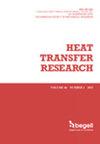Validating the First Law of Thermodynamics for Unsteady Flow in a Compression Wave Using Mathcad
IF 1.6
4区 工程技术
Q3 THERMODYNAMICS
引用次数: 0
Abstract
Classical thermodynamics traditionally overlooks the role of quantities dependent on spatial coordinates and time, especially in the context of unsteady flows. This research introduces the first law of thermodynamics (FLT) tailored for non-stationary flow, distinguishing itself with the inclusion of terms bearing partial derivatives of pressure, p(x, t), concerning coordinates and time (–υ(∂р/∂х)dx; –υ(∂р/∂t)dt). By employing this novel approach, the derived equations are validated using a centred compression wave as a representative non-stationary flow case study. A methodology is also presented for experimentally quantifying hydrodynamic energy losses in the intake and exhaust systems of internal combustion engines. Central to the exploration is the calculation of pressure forces' work –υ(∂р/∂х)dx and –υ(∂р/∂t)dt) in the FLT equation for non-stationary flows, particularly their applicability to a centred compression wave. Moreover, a distinct procedure for discerning friction work in non-stationary flow is delineated. The research methods encompass both analytical derivation and numerical simulations leveraging Mathcad software. The bespoke Mathcad program crafted for this study can graphically represent multiple flow parameters as functions of time, proving invaluable for comprehending compression wave dynamics and evaluating friction work in diverse non-steady flows. Ultimately, the incorporation of energy equations tailored for non-stationary flows into classical thermodynamics paves the way for a more comprehensive understanding and application of thermodynamics to intricate flow scenarios.用Mathcad验证压缩波非定常流动热力学第一定律
经典热力学传统上忽略了依赖于空间坐标和时间的量的作用,特别是在非定常流动的情况下。本研究介绍了为非平稳流动量身定制的热力学第一定律(FLT),其区别在于包含包含压力偏导数的项,p(x, t),涉及坐标和时间(-υ(∂r /∂r)dx;υ(∂р/∂t) dt)。通过采用这种新方法,推导出的方程以中心压缩波为代表的非平稳流动案例研究进行了验证。本文还提出了一种实验量化内燃机进气和排气系统中流体动力能量损失的方法。探索的核心是计算非平稳流动的FLT方程中压力的功-υ(∂r /∂r)dx和-υ(∂r /∂t)dt),特别是它们对中心压缩波的适用性。此外,一个独特的程序来识别摩擦功在非平稳流动描述。研究方法包括分析推导和利用Mathcad软件的数值模拟。为这项研究量身定制的Mathcad程序可以用图形表示多种流动参数作为时间的函数,这对于理解压缩波动力学和评估各种非稳定流动中的摩擦功是非常宝贵的。最终,将非平稳流动的能量方程纳入经典热力学,为更全面地理解和应用热力学来解决复杂的流动问题铺平了道路。
本文章由计算机程序翻译,如有差异,请以英文原文为准。
求助全文
约1分钟内获得全文
求助全文
来源期刊

Heat Transfer Research
工程技术-热力学
CiteScore
3.10
自引率
23.50%
发文量
102
审稿时长
13.2 months
期刊介绍:
Heat Transfer Research (ISSN1064-2285) presents archived theoretical, applied, and experimental papers selected globally. Selected papers from technical conference proceedings and academic laboratory reports are also published. Papers are selected and reviewed by a group of expert associate editors, guided by a distinguished advisory board, and represent the best of current work in the field. Heat Transfer Research is published under an exclusive license to Begell House, Inc., in full compliance with the International Copyright Convention. Subjects covered in Heat Transfer Research encompass the entire field of heat transfer and relevant areas of fluid dynamics, including conduction, convection and radiation, phase change phenomena including boiling and solidification, heat exchanger design and testing, heat transfer in nuclear reactors, mass transfer, geothermal heat recovery, multi-scale heat transfer, heat and mass transfer in alternative energy systems, and thermophysical properties of materials.
 求助内容:
求助内容: 应助结果提醒方式:
应助结果提醒方式:


